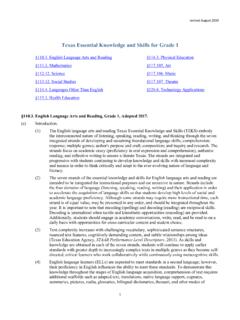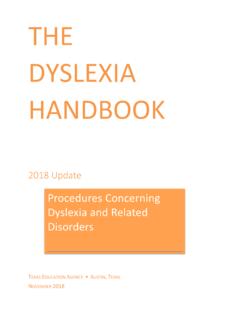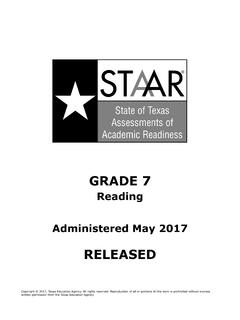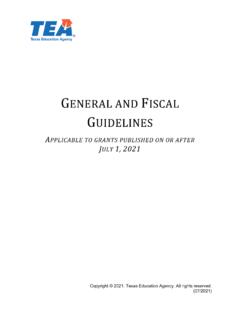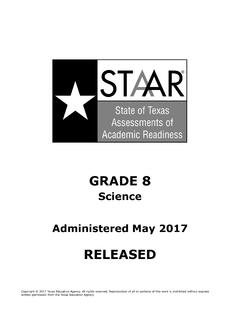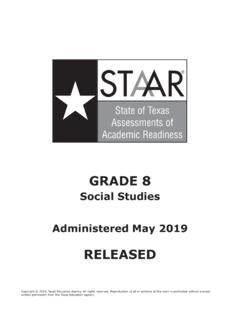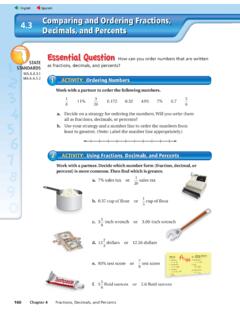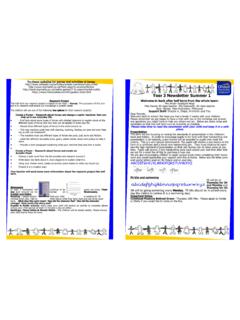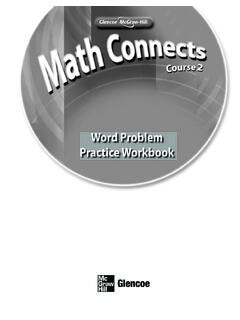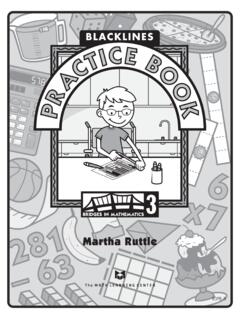Transcription of Grade 6 Mathematics
1 _____ TEKS Curriculum Framework for STAAR Alternate 2 Grade 6 Mathematics Copyright September 2016, Texas Education Agency. All rights reserved. Reproduction of all or p ortions of this work is prohibited without express written permission from the Texas Education Agency. Mathematics TEKS Curriculum Framework for STAAR Alternate 2 | Grade 6 STAAR Reporting Category 1 Numerical Representations and Relationships: The student will demonstrate an understanding of how to represent and manipulate numbers and expressions. TEKS Knowledge and Skills Statement/ STAAR-Tested Student Expectations ( ) Number and operations.
2 The student applies mathematical process standards to represent and use rational numbers in a variety of forms. The student is expected to (A) classify whole numbers, integers, and rational numbers using a visual representation such as a Venn diagram to describe relationships between sets of numbers; Supporting Standard (B) identify a number, its opposite, and its absolute value; Supporting Standard (C) locate, compare, and order integers and rational numbers using a number line; Supporting Standard (D) order a set of rational numbers arising from mathematical and real-world contexts; Readiness Standard (E) extend representations for division to include fraction notation such as a/b represents the same number as a b where b 0.
3 Supporting Standard Essence of TEKS Knowledge and Skills Statement/ STAAR-Tested Student Expectations Recognizes relationships in and between sets of numbers. Prerequisite Skills/Links to TEKS Vertical Alignment Representing and Using Fractions, Decimals, Per cents and Probability compare t wo fr actio ns with different numerators and different denominators and represent the comparison using the symbols >, =, or < determine if two given fr actions are equivalent using a variety of methods decompose a fr action in more than one way into a sum o f fr actio ns with t he same denominator using concrete and pictorial models and recording results with symbolic represe ntations represent a fr action a/b a s a sum of fr actions 1/b.
4 Where a a nd b a re whole numbers a nd b > 0, including when a > b relate decimals to fr actions that name tenths and hundredths represent decimals, including tenths and hundredths, using concrete and visual models and money compare t wo fr actions having the same numerator or denominator in problems by reasoni ng about their sizes and justifying the conclusion using symbols, words, objects, and pictorial models re present equivalent fr actions with denominators of 2, 3, 4, 6, and 8 using a variety of objects and pictorial models, including number lines Continued September 2016 1 Mathematics TEKS Curriculum Framework for STAAR Alternate 2 | Grade 6 September 2016 2 Prerequisite Skills/Links to TEKS Vertical Alignment solve problems involvin g partitioning an object or a set o f objects among two or more reci pients using pictorial representatio ns o f fr actions with denominators of 2, 3, 4, 6.
5 And 8 compose and decompose a fr action a/b with a numerator greater than zero and less than or equal to b as a sum of parts 1/b explain that the unit fr action 1/b re presents the quantity formed by one part of a whole that has been partitioned into b equal parts where b is a non-zero whole number represent fractio ns greater than zero and less than or equal to one with denominators of 2, 3, 4, 6, and 8 using concrete o bjects a nd pictorial models, including strip diagrams a nd number lines identify examples and non-examples o f halves, fourths, and eighths use concrete models to count fr actional parts beyond one whole using words and recognize how many parts it takes to equal one whole explain that the more fr actional parts used to make a whol e, the smaller the part.
6 The fewer the fractional parts, the larger the part partition objects i nto equal parts and name the parts, including halves, fourths, and eighths, using words identify examples and non-examples of halves and fourths partition two-dimensional figures into two and four fair shares or equal parts and describe the parts using words Determining and Simplifying Numeric and Algebraic Expressions simplify numerical expressions that do not involve exponents, including up to two levels of grouping describe the meaning of parentheses and brackets in a numeric expression re present the value of the digit in decimals through the thousandths using expanded notation and numerals represent the value of the digit in whole numbers through 1,000,000.
7 000 and decimals to the hundredths using expanded notation and numerals interpret the value of each place-value position as 10 times the position to the right and as one-tenth of the value of the place to its left describe the mathematical relationships found in the base-10 place value system through the hundred thousands place compose and decompose numbers up to 100,000 as a sum o f so many ten thousands, so many thousands, so many hundreds, so many tens, and so many ones using objects, pictorial models, and numbers, including expanded notation as appropriate use standard, word, and expanded forms to represent numbers up to 1,200 use concrete a nd pictorial models to compose and decompose numbers up to 1,200 in more than one way as a sum of so many thousands, hundreds, tens, and ones apply properties of operations to add and subtract two or three numbers use objects, pictures, and expanded and standard forms to represe nt numbers up to 120 use concrete a nd pictorial models to compose and decompose numbers up to 120 in more than one way as so many hundreds, so many tens.
8 And so many ones compose and decompose numbers up to 10 wit h objects and pictures Continued Mathematics TEKS Curriculum Framework for STAAR Alternate 2 | Grade 6 September 2016 3 Prerequisite Skills/Links to TEKS Vertical Alignment Identifying Points and Distances on Number Lines re present fractions and decimals to the tenths or hundredths as distances from zero on a number line determine the corresponding decimal to the tenths or hundredths place of a specified point on a number line represent fractions of halves, fourths, and eighths as distances from zero on a number line explain that two fr actions are equivalent if and only if they are both re presented by the same point on the number li ne or represent the same portion of a same size whole for an area model determine the corresponding fraction greater than zero and less than or equal to one with denominators of 2, 3, 4, 6, and 8 given a specified point on a number line re present a number on a number line as being between two consecutive multiples of 10; 100; 1,000.
9 Or 10,000 and use words to describe relative size o f numbers in order to round whole numbers represent whole numbers as distances from any given location on a number line name the whole number that corresponds to a specific point on a number line locate the position of a given whole number on an open number line Geometry and spatial sense skills demonstrate use of location words (such as over, under, above, on, beside, next to, between, in front of, near, far, etc.) comparing , ordering , and Rounding Numbers Using Place Value round decimals to tenths or hundredths compare and order two decimals to thousandths and represent comparisons using the symbols >, <, or = compare and order decimals using concrete and visual models to the hundredths round whole numbers to a given place value through the hundred thousands place compare and order whole numbers to 1,000,000,000 and represent comparisons using the symbols >, <, or = compare and order whole numbers up to 100,000 and represent comparisons using the symbols >, <.
10 Or = use an underst andi ng of place value to determine t he number that is 10 or 100 more o r less than a given number up to 1,200 use place value to compare and order whole numbers up to 1,200 using comparative language, numbers, and symbols (>, <, or =) use relationships to determine the number that is 10 more and 10 less than a given number up to 120 represent the comparison of two numbers to 100 using the symbols >,<, or = order whole numbers up to 120 using place value and open number lines use place value to compare whole numbers up to 120 using comparative language use comparative language to describe two numbers up to 20 presented as written numerals compare sets of objects up to at least 20 in each set using comparative language Continued Mathematics TEKS Curriculum Framework for STAAR Alternate 2 | Grade 6 September 2016 4 Prerequisite Skills/Links to TEKS Vertical Alignment Recognizing Numbers and Counting identify prime and composite numbers determine if a number is
